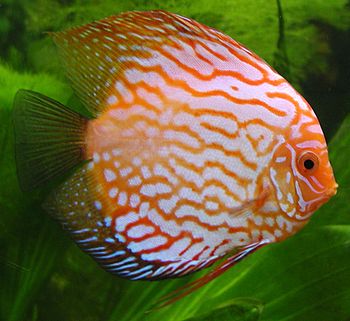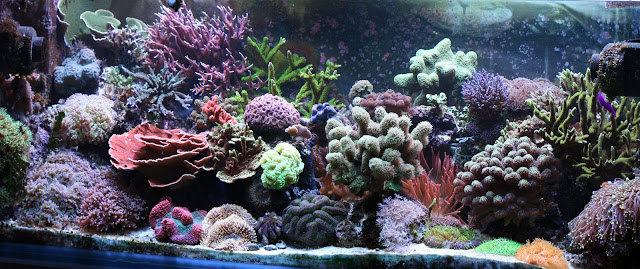 |
| The discus, Symphysodon spp., (Photo credit: Wikipedia) |
If you had the chance to explore all saltwater and freshwater fish, it would take you thousands of years. Therefore, if you are just starting in fish care and aquariums you want to learn minimal details on starter fish. Everyone has their own notion as to which fish are best for starters, therefore my goal is to inform you, rather than instruct on starter fish. Still, I will provide you helpful information that you can use to sort through aggressive and passive fish. The passive, peaceful, and easy to maintain fish are in my opinion the best fish for starters. Now we start with the Symphysodon aequifasciata and s. discus fish, which is known as the Discus Fish.
The name alone would make the common starter take a run for a name they could pronounce, yet the fish name is a scare, which denounces the fish’s identity. This fancy fish is brilliantly colored in aqua green with a brownish tint that offsets his eyes, small mouth, and black marked body. The Discus is one of the tropical fish that lives in freshwater. Discuss prefers water temperatures set at 82 degrees and no higher than 88 degrees Fahrenheit. The pH level should set at 6.0 and not beyond 6.5. Density: 3 to 5 degrees:
The Discus is slow feeders that tend to reside by themselves. The fish will live in communal tank water, yet they will find their own corners to hang. Some of the recommended fish to share space with the Discus is the smaller and peaceful Corydoras catfish, cardinal tetras, and the Rasbora. Few of the Discus fish are decorated in bright cyan red and turquoise, which makes the fish appealing to tank water. Before you purchase discus breeds, take care to review the health of these fish. It is next to impossible to save an ill discus’s life.
Discus has a shy nature. The peaceful fish enjoys slowness, and is finicky when dining. The foodstuff desired includes, live bait, frozen foods, beef heart shredded, Tubifex, etc. You want to avoid Tubifex although the fish enjoy the meal well, since these fish are prone to disease. You can feed the pet Tubifex, yet it is advised that you wash the foodstuff carefully.
 |
| A pair of bettas spawning under a bubble nest. (Photo credit: Wikipedia) |
If you want to feed a fancier fish, then checkout the Bettas, Gouramies and the Fighting Siamese Fish. The fish spread out in the waters of Asia and live well in aquariums. The fancy fish including the Siamese Fighting Fish, Fighting Cocks, and the Strains are popular fish that has been spotted on live sporting events. The fish are commonly exploited in Thailand’s’ land. The fish enjoy battling. Most of the fish available have a variety of colors to select from, including the beautiful shimmering red fish, blue fish, bicolor fish, and so on. Albinos are available as well.
In all fish are summed up as saltwater (Marine) fish or freshwater (Non-Marine) fish. The Freshwater fish include tropical fish and the coldwater fish. The tropical is more desirable for starters in fish care and aquarium keep. At pet stores, online, etc, you will find a wide array of tropical, saltwater, and coldwater fish.
Keep in mind that Marine fish are more prone to saltwater, since the fish come from salty marine waters, such as the seas, oceans, etc. Freshwater fish tend to come from rivers, lakes, streams, ponds, and so on. Having an idea of what type of water the fish dwells in can give you a running start to figuring out what type of water is best suited for your fish. Still, most pet stores provide instructions, which you should read carefully in your fish care expedition. Don’t forget the filtration systems.
|






